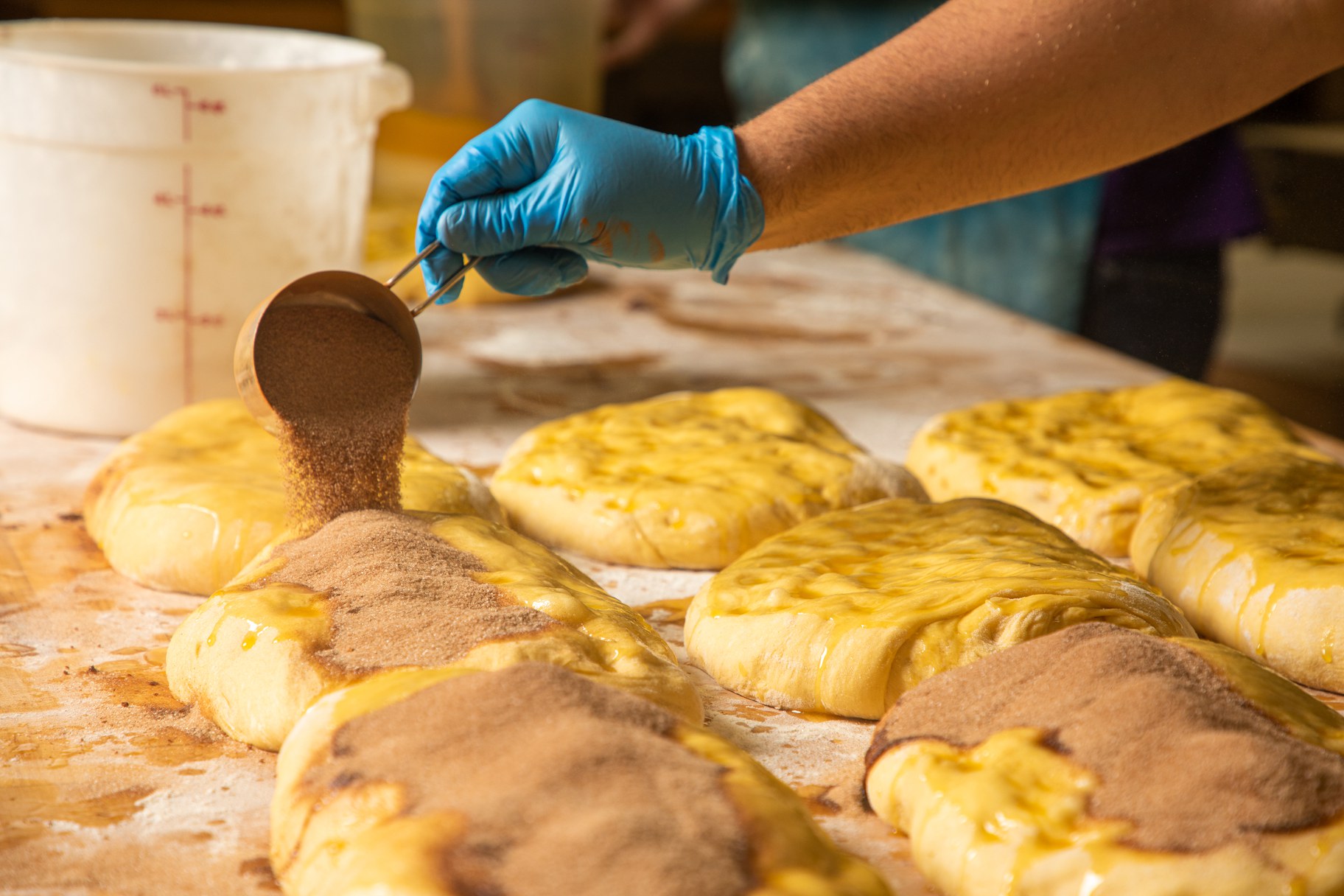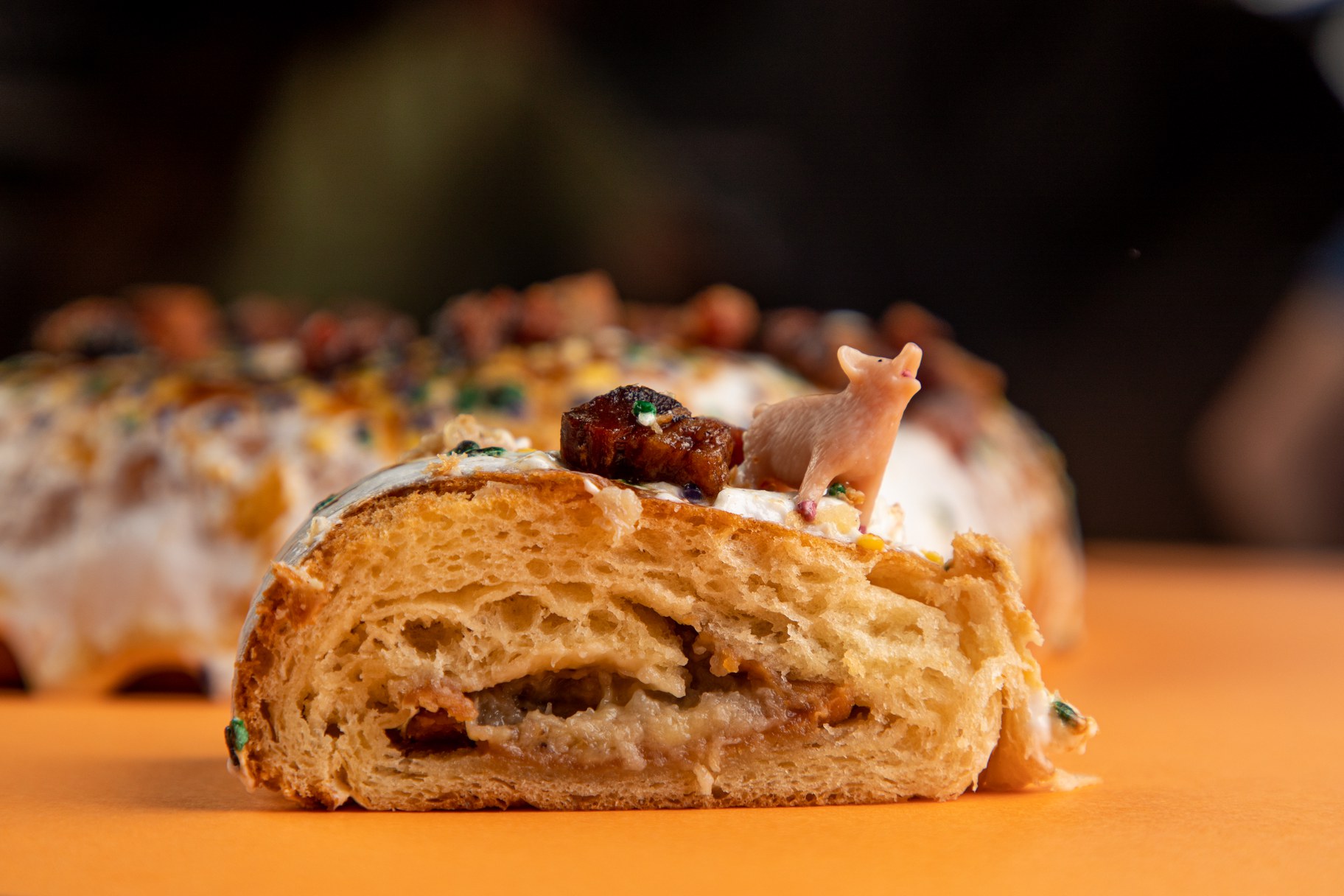Have you had your slice of king cake yet? If not, you better make plans soon because the rules of Mardi Gras say you only have from The Feast of the Epiphany on January 6 until Fat Tuesday, which falls on March 1 this year, to get your blinged-out rings of dough. If you’ve never been initiated into the world of king cake, you’re in for a treat.

A baker makes king cakes at famed bakery Randazzo’s in New Orleans. Photo by Randy Krause Schmidt.
Like most pastry traditions, there is a great deal of variety, but add in the New Orleans vibe, and you have everything from simple icing-free rings of sweetened dough to filled enriched dough rings covered with edible bling. Fillings range from the traditional sweetened cream cheese to creations from pastry chefs.
The most traditional decoration is sugar in the Mardi Gras triad of purple, green and gold. But new bakers push the envelope by airbrushing luster over the dough — or use chocolate, caramel drizzles, or even fruit and whipped cream. Toppings can be spare or lavish.
There is a new coffee table book celebrating the tradition, variety, and community that surround the pastry in New Orleans. It’s called “The Big Book of King Cake: The Stories & Bakers Behind New Orleans’ Sweetest Tradition” by Matt Haines. It’s a love letter to this joyous New Orleans tradition. Haines tasted and documented the stories of 80 of the city’s notable offerings. It’s a life-affirming celebration of a New Orleans fundamental tradition.
Back to the cake and about those colors — one persistent myth about their origin begins in 1872 when the first Rex parade king chose them to honor the Russian Duke, Alexei Alexandrovich Romanoff. The Mardi Gras king of 1982 gave a meaning to each color: gold for power, purple for justice, and green for faith.
Where did the tradition start and what about that plastic baby? It all starts in Rome, with the ancient pagan free-for-all known as Saturnalia, where community feasting included a cake with a bean hidden inside. The person who found the bean became the king or queen of the day.
When Catholicism came into the picture, they found a perfect pivot for the cake. It went from celebrating the sun god to the Epiphany, the day three kings bring gifts to baby Jesus. Spanish, Portuguese and Southern French colonizers and settlers to Louisiana brought their traditions of roscón de reyes, bolo rei, and gȃteau de rois (cake of kings) to the area. The cakes were made of a rich dough baked in the shape of a ring and contained a bean.

If you get the baby, or pig in the case of cakes at Cochon Butcher, you have to buy the king cake for your group’s next celebration. Photo by Randy Krause Schmidt.
Centuries later and the famed King Cake of New Orleans is richer, sweeter, more colorful, and the bean is now a plastic baby. If you get the baby, you have to bring the next king cake to your group celebration, since sharing the cake with friends and family is what it’s all about.
NOCHI King Cake Recipe
Courtesy of the New Orleans Culinary & Hospitality Institute

The recipe for NOCHI King Cake involves a cinnamon filling, butter, eggs, honey, sugar and food coloring, of course the small plastic baby, and more. Credit: New Orleans Culinary & Hospitality Institute.
Ingredients
Cinnamon Filling:
- 1/3 cup butter
- 1/3 cup brown sugar
- 1 tbsp all-purpose flour
- 1 tbsp cinnamon
- 1 tbsp honey
- 1/2 egg (reserve the other half for the dough)
- ¼ tsp vanilla extract
Dough:
- 2 ½ cups bread flour
- ¾ tsp yeast, instant or rapid rise
- 3 tbsp + 1 tsp sugar
- 1 tsp salt
- 1/3 cup butter
- 1 ½ eggs
- ½ tsp honey
- 2/3 cup milk
Icing and Cake Decorating:
- 2 cups powdered sugar
- ¼ cup whole milk
- 1 tsp vanilla extract
- Sugar and food coloring as desired
- Small plastic baby
Instructions
Start by making the cinnamon filing.
- Melt the butter.
- Pour the melted butter into a bowl and mix with the brown sugar until well combined.
- Add the flour, cinnamon, and honey. Mix well.
- Add the eggs and vanilla extract. Mix well.
- Cover and place in the refrigerator until ready to use.
Next, it’s time to make your king cake dough.
- Place all dough ingredients in a large bowl. Make sure butter is soft.
- Mix ingredients on low speed using a stand mixer for 4 minutes until well combined. If you don't have a mixer, that's also fine; you’ll just need more elbow grease.
- Next, mix ingredients on medium speed for approximately 6 minutes. To check if the dough is ready, tear off a small piece. You should be able to stretch it thin enough to see light coming through without the dough tearing.
- Cover the bowl with plastic wrap or a clean dishtowel and set aside for 30 minutes to begin proofing the dough.
- Transfer the dough to a floured surface and roll into a rectangle with 1 inch thickness.
- Move the dough to a tray or baking sheet and cover it with plastic wrap. Place it in the refrigerator overnight to continue proofing.
- When you are ready to bake, remove the dough from the refrigerator and let it sit for 30 minutes.
- Roll the dough into a rectangle (approximately 20 x 8 inches).
- Spread the cinnamon filling on the rectangle and fold in half lengthwise. Your folded dough should be approximately 20 x 4 inches.
- Cut the dough into 3 even strips lengthwise.
- Stretch the strips to 24 inches each. Braid the 3 pieces, then shape into a circle or oval.
- Line a baking sheet with parchment paper and place the unbaked cake on it.
- Cover and set aside in a warm place for approximately 1.5 hours, or until it’s nearly double its size (for home bakers, a good trick is to place the unbaked cake on the middle rack of an oven that’s off. Place a pan of hot water on the oven floor).
- Bake at 325°F until golden brown or until the cake is at an internal temperature of 190°F. This will be approximately 12 to 15 minutes in a convection oven or approximately 20 minutes in a regular oven.
Finally, everyone’s favorite part – decorating!
- Combine powdered sugar, whole milk, and vanilla extract in a bowl. Mix until smooth and set side.
- To make colored sugars, put sugar into three bowls—one for purple, another for green, and a third for gold. Start with a few drops of coloring, mixing until incorporated. Add more, a few drops at a time, until your sugar is the desired color.
- Once the cake has cooled, lift the cake and insert the baby into the bottom for the future queen or king to find.
- Drizzle the icing over the cake.
- Sprinkle sugar on top, alternating between the three colors.
- Eat and repeat.
